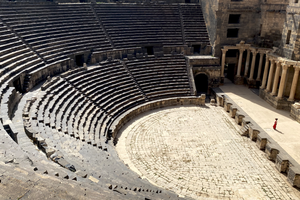
Ok, so it’s more of a dark gray, but the Roman amphitheater found in Bosra, Syria, is no less impressive on that count. Quarried from the nearby black volcanic rock, this amphitheater and its surrounding city are some of the best-preserved Roman ruins on the planet. This is despite, and perhaps in defiance of, the destructive efforts of military insurgents over the past decade.
Built on the foundations of a Nabetean city, the amphitheater dates to the second century when it was erected during Trajan’s eastward expansion of the empire. Able to hold an estimated 17,000 spectators, the size of the theater indicates both a prosperous and burgeoning Roman population along this important trade route.
During the rise of Christianity in the Eastern Empire, the site fell into neglect, with the Byzantine rulers finding classical theater pagan and distasteful. In the Middle Ages, the already formidable structure was reinforced with surrounding walls and served as a citadel for a succession of Islamic dynasties until it once again fell into disuse, eventually filling with sand.
And that is most likely why the structure survived as well as it did during the most recent civil unrest. It was buried, protecting most of the statues, carvings, and delicate mosaics from looters and errant bullets. One mosaic, in particular, is so well preserved that an image of it adorns the reverse side of Syrian 1,000-pound currency notes.
Efforts by both Syrian locals and international organizations have repaired and rebuilt much of the damaged areas, and this gem of the Roman Empire is tentatively open to the intrepid visitor once again.

Post a Comment